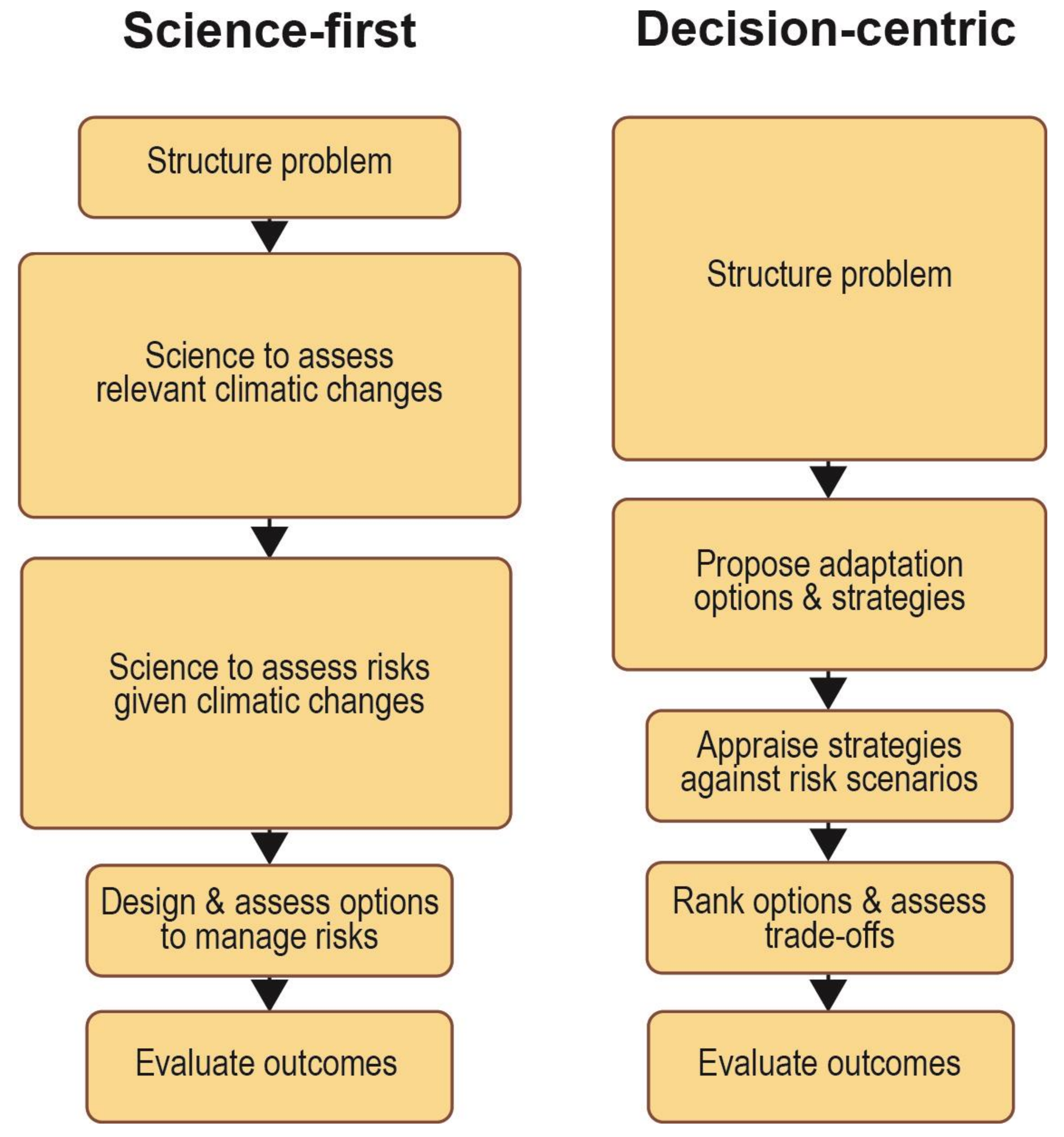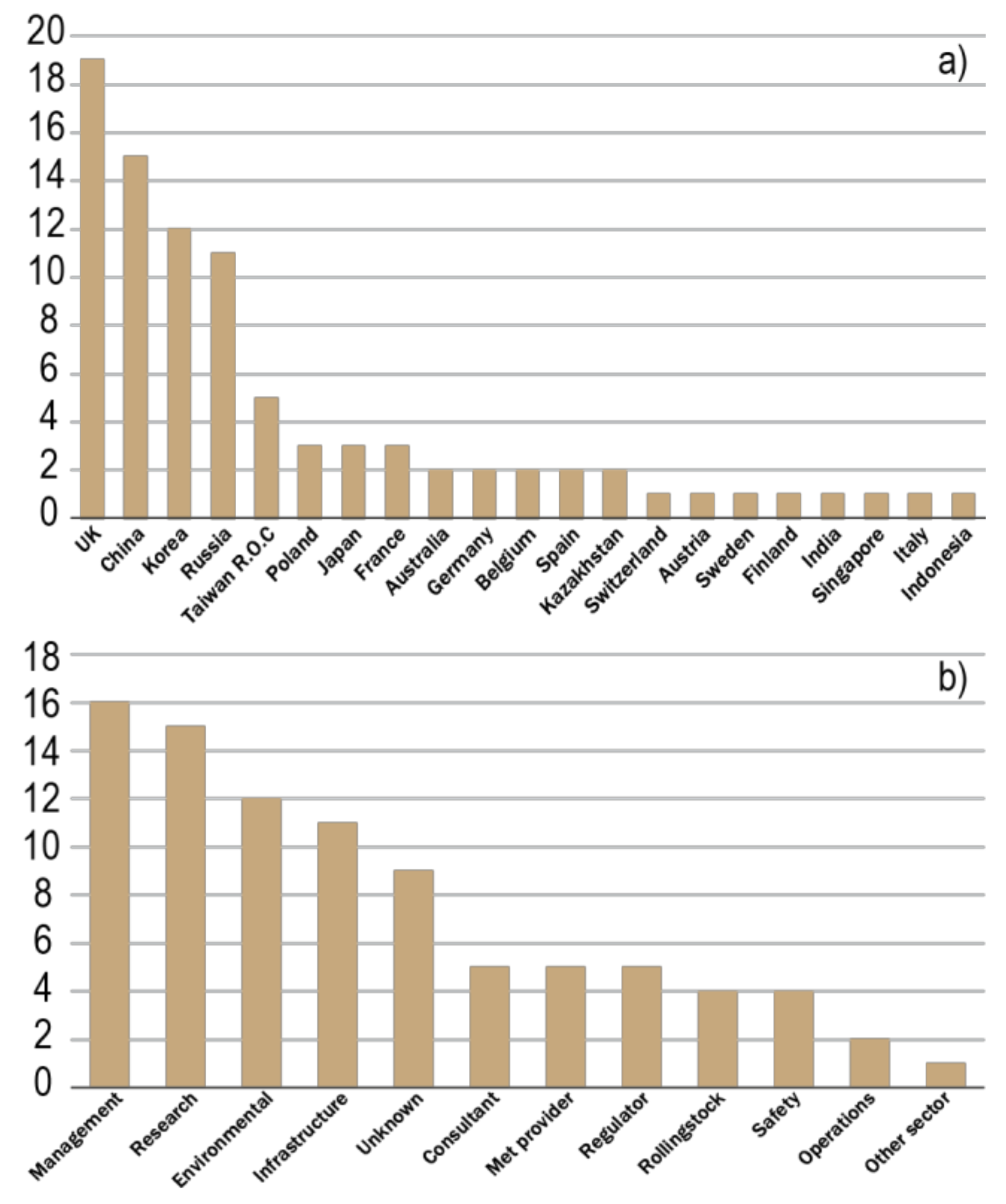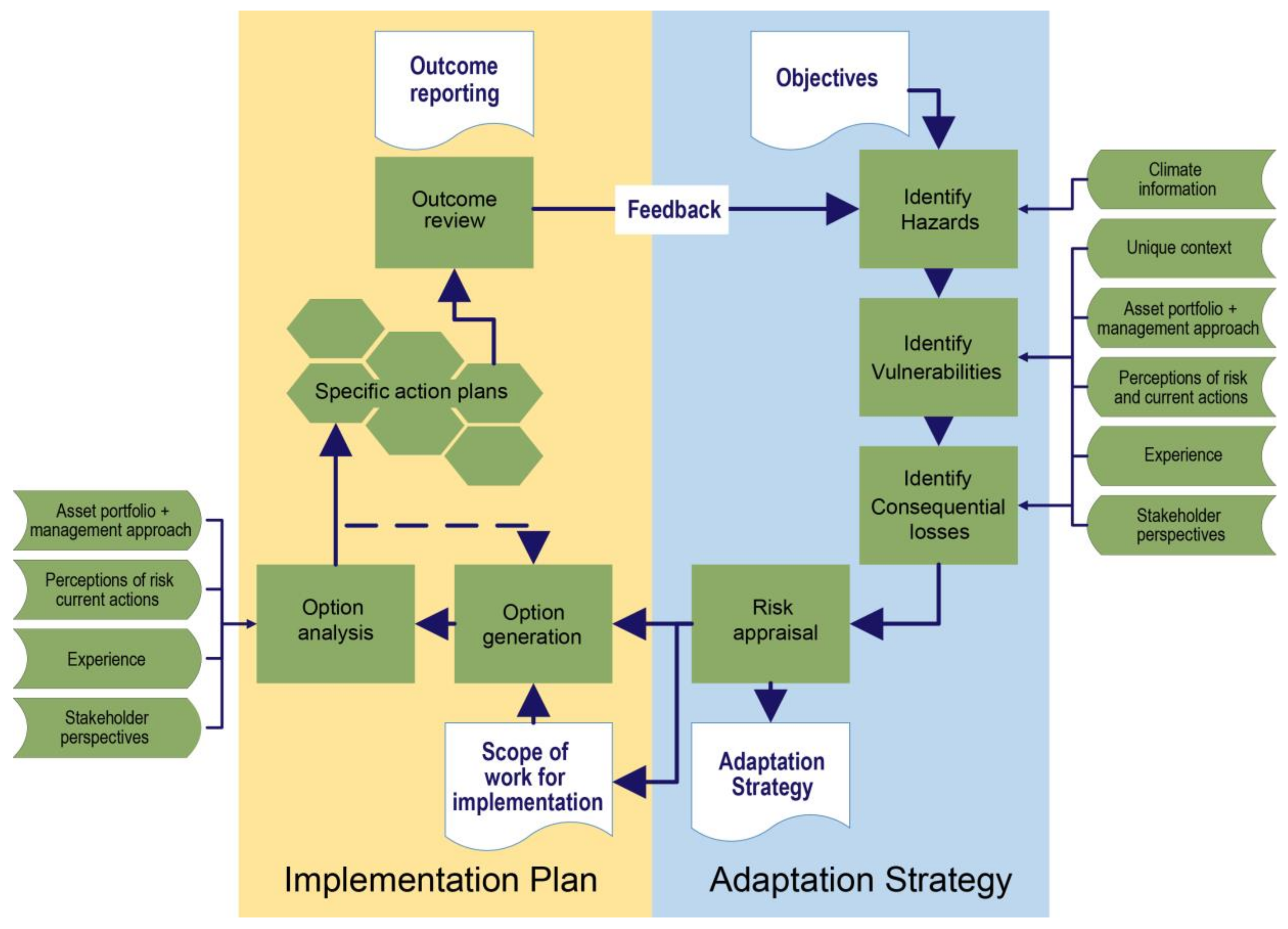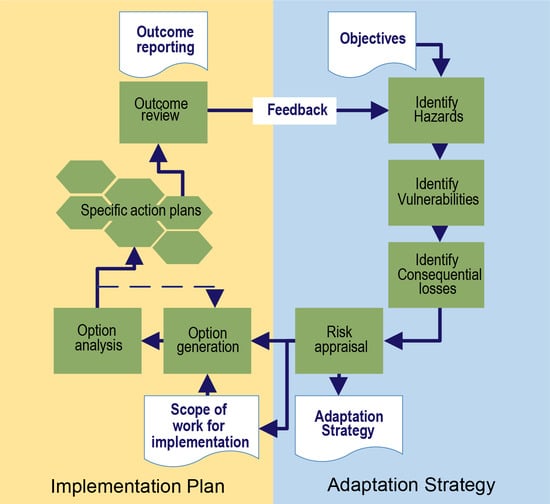Adaptation Becoming Business as Usual: A Framework for Climate-Change-Ready Transport Infrastructure
Abstract
:1. Introduction
2. Methods
2.1. Literature Review of Current Best Practice and Academic Research
2.2. Stakeholder Engagment
3. Results and Discussion
3.1. Initial Outcomes from Stakeholder Workshops
- Any framework should avoid reinvention by building on what is already underway in existing activities, projects and processes, for example the ISO standards already provide appropriate mechanisms in areas such as asset management.
- Linkages should exist between the adaptation and greenhouse gas emission reduction agendas, thereby widening options for response, as well as with risk management processes in safety and business continuity.
- People from different areas of a business or organisation will have knowledge or experience which will be relevant for adapting to climate change. These personnel can lend support and expertise, and their involvement will increase “buy-in” and acceptance of adaptation more broadly through the organisation.
- Building links with external organisations and stakeholders is vital to avoid maladaptation by reinvention, lock-in, poor understanding of some aspects of the challenges, or by cutting across or undermining the plans of others.
- Stakeholders in different transport modes should work together to develop compatible processes and allow for mutual benefits.
- The process of climate change adaptation should be responsive and iterative, and not linear. The framework should have the capacity to incorporate the new information and experience, and the new questions and challenges this will raise.
3.2. A Framework for Climate-Change-Ready Transport Infrastructure
3.2.1. Adaptation Strategy
3.2.2. Implementation Plan
3.3. Stakeholder Feedback on the Framework for Climate-Change-Ready Transport Infrastructure
4. Conclusions
Acknowledgments
Author Contributions
Conflicts of Interest
References
- Hartmann, D.L.; Tank, A.M.G.K.; Rusticucci, M. Chapter 2: Observations: Atmosphere and Surface. In Climate Change 2013 the Physical Science Basis: Working Group I Contribution to the Fifth Assessment Report of the Intergovernmental Panel on Climate Change; Cambridge University Press: Cambridge, UK, 2013; p. 165. [Google Scholar]
- Beniston, M.; Stephenson, D.B.; Christensen, O.B.; Ferro, C.A.T.; Frei, C.; Goyette, S.; Halsnaes, K.; Holt, T.; Jylhä, K.; Koffi, B.; et al. Future extreme events in European climate: An exploration of regional climate model projections. Clim. Chang. 2007, 81, 71–95. [Google Scholar] [CrossRef]
- Wigley, T.M.L. The effect of changing climate on the frequency of absolute extreme events. Clim. Chang. 2009, 97, 67–76. [Google Scholar] [CrossRef]
- Cai, W.; Borlace, S.; Lengaigne, M.; Van Rensch, P.; Collins, M.; Vecchi, G.; Timmermann, A.; Santoso, A.; Mcphaden, M.J.; Wu, L.; et al. Increasing frequency of extreme El Niño events due to greenhouse warming. Nat. Clim. Chang. 2014, 4, 111–116. [Google Scholar] [CrossRef] [Green Version]
- Jaroszweski, D.; Hooper, E.; Baker, C.; Chapman, L.; Quinn, A. The impacts of the 28 June 2012 storms on UK road and rail transport. Meteorol. Appl. 2015, 22, 470–476. [Google Scholar] [CrossRef]
- Koetse, M.J.; Rietveld, P. The impact of climate change and weather on transport: An overview of empirical findings. Transp. Res. Part D Transp. Environ. 2009, 14, 205–221. [Google Scholar] [CrossRef]
- McEvoy, D.; Ahmed, I.; Mullett, J. The impact of the 2009 heat wave on Melbourne’s critical infrastructure. Local Environ. 2012, 17, 783–796. [Google Scholar] [CrossRef]
- Palin, E.J.; Thornton, H.E.; Mathison, C.T.; McCarthy, R.E.; Clark, R.T.; Dora, J. Future projections of temperature-related climate change impacts on the railway network of Great Britain. Clim. Chang. 2013, 120, 71–93. [Google Scholar] [CrossRef]
- Ferranti, E.; Chapman, L.; Lowe, C.; McCulloch, S.; Jaroszweski, D.; Quinn, A. Heat-Related Failures on Southeast England’s Railway Network: Insights and Implications for Heat Risk Management. Weather Clim. Soc. 2016, 8, 177–191. [Google Scholar] [CrossRef]
- Ferranti, E.; Chapman, L.; Lee, S.; Jaroszweski, D.; Lowe, C.; McCulloch, S.; Quinn, A. The hottest July day on the railway network: Insights and thoughts for the future. Meteorol. Appl. 2017. [Google Scholar] [CrossRef]
- Lindau, L.A.; Petzhold, G.; Tavares, V.B.; Facchini, D. Mega events and the transformation of Rio de Janeiro into a mass-transit city. Res. Transp. Econ. 2016, 59, 196–203. [Google Scholar] [CrossRef]
- Dawson, D.; Shaw, J.; Roland Gehrels, W. Sea-level rise impacts on transport infrastructure: The notorious case of the coastal railway line at Dawlish, England. J. Transp. Geogr. 2016, 51, 97–109. [Google Scholar] [CrossRef]
- Christensen, J.H.; Carter, T.R.; Rummukainen, M.; Amanatides, G. Evaluating the perfomance of regional climate models: The prudence project. Clim. Chang. 2007, 81, 1–6. [Google Scholar] [CrossRef]
- Dobney, K.; Baker, C.J.; Quinn, A.D.; Chapman, L. Quantifying the effects of high summer temperatures due to climate change on buckling and rail related delays in south-east United Kingdom. Meteorol. Appl. 2009, 16, 245–251. [Google Scholar] [CrossRef]
- Chinowsky, P.S.; Price, J.C.; Neumann, J.E. Assessment of climate change adaptation costs for the U.S. road network. Glob. Environ. Chang. 2013, 23, 764–773. [Google Scholar] [CrossRef]
- Rosenzweig, C.; Solecki, W. Hurricane Sandy and adaptation pathways in New York: Lessons from a first-responder city. Glob. Environ. Chang. 2014, 28, 395–408. [Google Scholar] [CrossRef]
- Department for Transport. Transport Resilience Review: A Review of the Resilience of the Transport Network to Extreme Weather Events; His (or Her) Majesty’s Stationery Office (HMSO): London, UK, 2014.
- Mullan, M.; Kingsmill, N.; Agrawala, S.; Kramer, A.M. National adaptation planning: Lessons from OECD countries. In Handbook of Climate Change Adaptation; Springer: Berlin/Heidelberg, Germany, 2015; pp. 1165–1182. ISBN 9783642386701. [Google Scholar]
- Preston, B.L.; Westaway, R.M.; Yuen, E.J. Climate adaptation planning in practice: An evaluation of adaptation plans from three developed nations. Mitig. Adapt. Strateg. Glob. Chang. 2011, 16, 407–438. [Google Scholar] [CrossRef]
- Rail Safety and Standards Board (RSSB). Tomorrow’s Railway and Climate Change Adaptation: Work Package 1 Summary Report. The Arup TRaCCA WP1 Consortium (Arup, CIRIA, JBA Consulting, the Met Office and the University of Birmingham) in collaboration with the RSSB Project Team (RSSB, John Dora Con); RSSB: London, UK, 2015. [Google Scholar]
- Quinn, A.D.; Jack, A.; Hodgkinson, S.; Ferranti, E.J.S.; Beckford, J.; Dora, J. Rail Adapt: Adapting the Railway for the Future; A Report for the International Union of Railways (UIC); UIC: Paris, France, 2017. [Google Scholar]
- PIANC Guidance on Climate Change Adaptation for Ports and Inland Waterways. Available online: http://www.pianc.org/climatechangeadaptation.php (accessed on 31 December 2017).
- Pakistan Agricultural Research Council (PIARC). Transport Strategies for Climate Change Mitigation and Adaptation; PIARC: Paris, France, 2016. [Google Scholar]
- International Transport Forum. Adapting Transport to Climate Change and Extreme Weather: Implications for Infrastructure Owners and Network Managers; International Transport Forum: Paris, France, 2016. [Google Scholar]
- Highways Agency. Climate Change Adaptation Strategy and Framework Revision B; Highways Agency: Guildford, UK, 2009. [Google Scholar]
- Network Rail. Climate Change Adaptation Report; Network Rail: London, UK, 2015. [Google Scholar]
- ART Adapting to Rising Tides. Available online: http://www.adaptingtorisingtides.org/ (accessed on 24 January 2018).
- Regmi, M.B.; Hanaoka, S. A survey on impacts of climate change on road transport infrastructure and adaptation strategies in Asia. Environ. Econ. Policy Stud. 2011, 13, 21–41. [Google Scholar] [CrossRef]
- Eisenack, K.; Stecker, R.; Reckien, D.; Hoffmann, E. Adaptation to climate change in the transport sector: A review of actions and actors. Mitig. Adapt. Strateg. Glob. Chang. 2012, 17, 451–469. [Google Scholar] [CrossRef]
- Jaroszweski, D.; Chapman, L.; Petts, J. Assessing the potential impact of climate change on transportation: The need for an interdisciplinary approach. J. Transp. Geogr. 2010, 18, 331–335. [Google Scholar] [CrossRef]
- Environment Agency. Thames Estuary Plan; Environment Agency: Bristol, UK, 2012. [Google Scholar]
- Haasnoot, M.; Schellekens, J.; Beersma, J.J.; Middelkoop, H.; Kwadijk, J.C.J. Transient scenarios for robust climate change adaptation illustrated for water management in the Netherlands. Environ. Res. Lett. 2015, 10. [Google Scholar] [CrossRef]
- Ministry for the Environment. Coastal Hazards and Climate Change: Guidance for Local Government; Ministry for the Environment: Wellington, New Zealand, 2017.
- Ranger, N.; Reeder, T.; Lowe, J. Addressing “deep” uncertainty over long-term climate in major infrastructure projects: Four innovations of the Thames Estuary 2100 Project. EURO J. Decis. Process. 2013, 1, 233–262. [Google Scholar] [CrossRef]
- Wilby, R.L.; Dessai, S. Robust adaptation to climate change. Weather 2010, 65, 180–185. [Google Scholar] [CrossRef]
- Kingsborough, A.; Jenkins, K.; Hall, J.W. Development and appraisal of long-term adaptation pathways for managing heat-risk in London. Clim. Risk Manag. 2017, 16, 73–92. [Google Scholar] [CrossRef]
- Lawrence, J.; Reisinger, A.; Mullan, B.; Jackson, B. Exploring climate change uncertainties to support adaptive management of changing flood-risk. Environ. Sci. Policy 2013, 33, 133–142. [Google Scholar] [CrossRef]
- Haasnoot, M.; Middelkoop, H.; Offermans, A.; van Beek, E.; van Deursen, W.P.A. Exploring pathways for sustainable water management in river deltas in a changing environment. Clim. Chang. 2012, 115, 795–819. [Google Scholar] [CrossRef]
- Beckford, J. The Intelligent Organisation: Realising the Value of Information; Routledge: Abingdon, UK, 2015; ISBN 9781317538677. [Google Scholar]
- Pidgeon, N.F.; Fischhoff, B. The role of social and decision sciences in communicating uncertain climate risks. Nat. Clim. Chang. 2011, 1, 35–41. [Google Scholar] [CrossRef]
- Sanderson, M.G.; Ford, G.P. Projections of severe heat waves in the United Kingdom. Clim. Res. 2016, 71, 63–73. [Google Scholar] [CrossRef]
- Royal Society Study Group. Risk Analysis, Perception and Management; Royal Society Study Group: London, UK, 1992. [Google Scholar]
- Hall, J.W.; Henriques, J.J.; Hickford, A.J.; Nicholls, R.J. Systems-of-systems analysis of national infrastructure. Proc. Inst. Civ. Eng. Eng. Sustain. 2013, 166, 249–257. [Google Scholar] [CrossRef]
- Sanderson, M.G.; Hanlon, H.M.; Palin, E.J.; Quinn, A.D.; Clark, R.T. Analogues for the railway network of Great Britain. Meteorol. Appl. 2016, 23, 731–741. [Google Scholar] [CrossRef]
- The National Audit Office (NAO). Reducing Passenger Rail Delays by Better Management of Incidents; The National Audit Office: London, UK, 2008.
- Denton, F.; Wilbanks, T.J.; Abeysinghe, A.C.; Burton, I.; Gao, Q.; Lemos, M.C.; Masui, T.; O’Brien, K.L.; Warner, K.; Bhadwal, S.; et al. Climate-resilient pathways: Adaptation, mitigation, and sustainable development. In Climate Change 2014 Impacts, Adaptation and Vulnerability: Part A: Global and Sectoral Aspects; Cambridge University Press: Cambridge, UK, 2015; pp. 1101–1131. ISBN 9781107415379. [Google Scholar]
- Holling, C.S. Engineering Resilience versus Ecological Resilience. In Engineering within Ecological Constraints; National Academies Press: Washington, DC, USA, 1996; pp. 31–44. ISBN 0309051983. [Google Scholar]
- D’Lima, M.; Medda, F. A new measure of resilience: An application to the London Underground. Transp. Res. Part A Policy Pract. 2015, 81, 35–46. [Google Scholar] [CrossRef]
- Mattsson, L.G.; Jenelius, E. Vulnerability and resilience of transport systems—A discussion of recent research. Transp. Res. Part A Policy Pract. 2015, 81, 16–34. [Google Scholar] [CrossRef]
- Wang, J.Y.T. “Resilience thinking” in transport planning. Civ. Eng. Environ. Syst. 2015, 32, 180–191. [Google Scholar] [CrossRef]
- Kellermann, P.; Schöbel, A.; Kundela, G.; Thieken, A.H. Estimating flood damage to railway infrastructure—The case study of the March River flood in 2006 at the Austrian Northern Railway. Nat. Hazards Earth Syst. Sci. 2015, 15, 2485–2496. [Google Scholar] [CrossRef]
- Ferranti, E.J.S.; Quinn, A.D.; Fontana Oberling, D. Transport resilience to weather and climate: A perspective from Rio de Janeiro, Brazil. Travel Behav. Soc. 2018. submitted. [Google Scholar]



© 2018 by the authors. Licensee MDPI, Basel, Switzerland. This article is an open access article distributed under the terms and conditions of the Creative Commons Attribution (CC BY) license (http://creativecommons.org/licenses/by/4.0/).
Share and Cite
Quinn, A.D.; Ferranti, E.J.S.; Hodgkinson, S.P.; Jack, A.C.R.; Beckford, J.; Dora, J.M. Adaptation Becoming Business as Usual: A Framework for Climate-Change-Ready Transport Infrastructure. Infrastructures 2018, 3, 10. https://doi.org/10.3390/infrastructures3020010
Quinn AD, Ferranti EJS, Hodgkinson SP, Jack ACR, Beckford J, Dora JM. Adaptation Becoming Business as Usual: A Framework for Climate-Change-Ready Transport Infrastructure. Infrastructures. 2018; 3(2):10. https://doi.org/10.3390/infrastructures3020010
Chicago/Turabian StyleQuinn, Andrew D., Emma J. S. Ferranti, Simon P. Hodgkinson, Anson C. R. Jack, John Beckford, and John M. Dora. 2018. "Adaptation Becoming Business as Usual: A Framework for Climate-Change-Ready Transport Infrastructure" Infrastructures 3, no. 2: 10. https://doi.org/10.3390/infrastructures3020010





